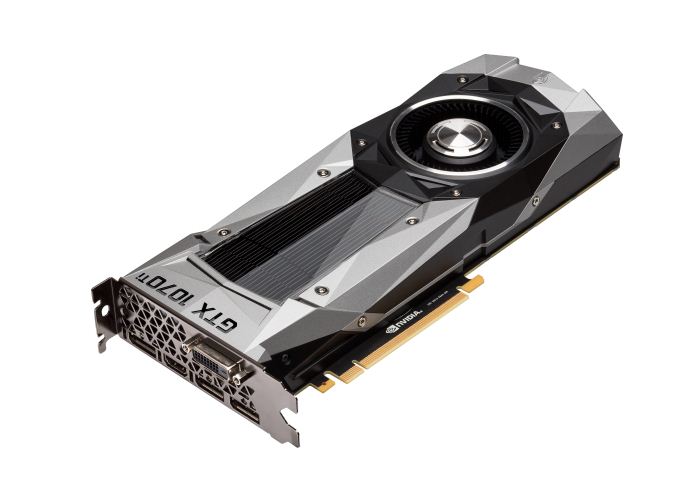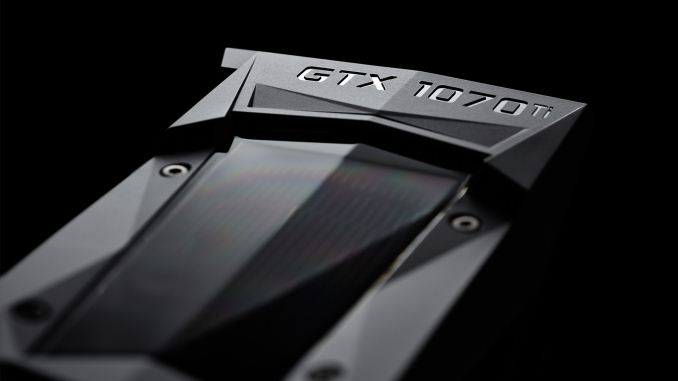The NVIDIA GeForce GTX 1070 Ti Founders Edition Review: GP104 Comes in Threes
by Nate Oh on November 2, 2017 9:00 AM EST- Posted in
- GPUs
- GeForce
- NVIDIA
- Pascal
- GTX 1070 Ti
Final Words
Bringing this review to a close, for better or worse, I think this is a launch that pulls no punches and offers no surprises. While AMD's Radeon RX Vega launch was not as impactful as many of us were hoping, it nonetheless had an impact. And that impact was against the GeForce GTX 1070, where the RX Vega 56 was fast enough to give AMD an edge on price/performance; at least when the card could be found in stock for near-MSRP prices.
Given that the RX Vega 56 placed between the GeForce GTX 1080 and GTX 1070, it was really up to NVIDIA as to if they wanted to respond, and to how. A third card in the enthusiast product stack is the straightforward solution to that problem, as it allows NVIDIA to reinforce their video card lineup against whatever foothold AMD can take. NVIDIA is playing a numbers game here – one that puts their new card just $50 below the GTX 1080 – but it's a careful calculus all the same. This is what a competitive market looks like: a little messier for sure, but also one where there are actions and reactions that give consumers more and better options.
Looking back at NVIDIA’s numbers, they seem more-or-less accurate. Based on the testing done for this review, our numbers have the GTX 1070 Ti around 13% faster than the GTX 1070, and about 8% slower than the GTX 1080. But this doesn’t support or reject the idea that the GTX 1080-1070 performance gap is capable of sustaining a new model there.
Comparing the GTX 1070 Ti head-to-head with AMD's Radeon RX Vega 56 is a little trickier, depending on the games. Generally speaking, the GTX 1070 Ti Founders Edition looks to be on the order of 5% faster than the reference RX Vega 56. The main question then returns to a matter of pricing. Just last week ahead of the GTX 1070 Ti announcement, the RX Vega 64 and RX Vega 56 were selling for $569 and $469 respectively. Since then, they've dropped by $50-$70, with retail prices running around $509 and $399 respectively, almost spot-on MSRP (if at last). Meanwhile as AMD's card prices continue to fluctuate, the new GTX 1070 Ti cards will have to remain within their $449 to $500 range, bounded by the $509 GTX 1080 and the $409 1070.
When graphics card prices change frequently, as they are now, numerous cards will drop in and out of the $250 - $550 area. Recommending the GTX 1070 Ti necessarily pigeonholes consumers to the $449 - $500 price bracket, which seems unwise when they still have the options of looking at cheaper GTX 1080 models, heavily overbuilt GTX 1070s, or even reference RX Vega 56s, all of which have been oscillating in price freely over the past couple of months. In real-world terms, as discussed earlier, today that might be the MSI GTX 1080 Armor 8G and EVGA GTX 1070 FTW Hybrid, both at the same price as a $499 GTX 1070 Ti. Or to put things another way, just last week the GeForce GTX 1070 Ti was poised to be RX Vega 56's direct competitor; this week its more of of a tantalizing spoiler for those who can reach a bit deeper into their wallets.
When it comes to comparing the GTX 1070 Ti to the RX Vega 56, it's ultimately a question of how competitive NVIDIA wishes to be and how quickly they want to react. If NVIDIA needs to completely cut-off the RX Vega 56, they can lower prices, otherwise if they just want to force AMD & vendors to bring their own prices back down to MSRP, then that job has just been done. Otherwise, looking briefly at the RX Vega 64 comparison, as you might expect from how it compares to the GTX 1080, the GTX 1070 Ti doesn't quite have the performance to outdo AMD's flagship air cooled card, leaving AMD in the lead by 5%. This means that the GTX 1070 Ti isn't the RX Vega 64's direct competitor either, however it's a potential spoiler by offering 90-95% of the gaming performance for 88% of the cost (not to mention the superior power efficiency).
Meanwhile, speaking very strictly here just within NVIDA's product stack, at today's $409/$449/$509 prices, the GTX 1070 Ti is, if only slightly, the best bargain of the three cards: it's 13% faster than the GTX 1070 for an 10% price increase, and similarly, the last 8% of the performance of the GTX 1080 comes with a 13% price premium. Otherwise all three cards are very similar, scaling in performance, price, and power consumption as you traverse the narrow $100 range. NVIDIA is pitching the GeForce GTX 1070 Ti as an upgrade for the practically legendary GTX 970, however since it launched at only $329, the GTX 970 was never this expensive. Arguably this is more of a late upgrade option for the GTX 980, but at this point I'm splitting hairs. If you are upgrading from an older NVIDIA card, you have a clear price/performance spectrum to pick from.
Otherwise, as custom GTX 1070 Ti cards hit the market over the next few weeks and settle down, it will become clearer what options they bring and how they fit into the market. Looking at our results, a factory-overclocked custom GTX 1070 Ti could easily hit GTX 1080 levels, but is not likely to be an option for precisely that reason.
Returning to the GTX 1070 Ti Founders Edition, it is a solid card with the GTX 1080 Founders Edition's vapor chamber cooler and reference 5+1 power phase PCB, all at a static $449 and reasonable power consumption. But ultimately it is a reference card with performance in between the GTX 1070 and GTX 1080, with a price to match. Given that GTX 1080 and 1070 models have been in that space for some time, that price point may be better some days and not on others for what you need. This isn't a card that is meant to drastically alter the enthusiast video card market in the last months of the year – which is to say that it doesn't do much to alter the balance between NVIDIA and AMD – but rather it's a card that is designed to offer a proportional option between the GTX 1080 and GTX 1070.












78 Comments
View All Comments
BrokenCrayons - Thursday, November 2, 2017 - link
This review was a really good read. I also like that the game screenshots were dropped from it since they didn't exactly add much, but do eat a little of my data plan when I'm reading from a mobile device.As for the 1070 Ti, agreed its priced a bit too high. However, I think most of the current-gen GPUs are pushing the price envelope right now. Except maybe the 1030 of course which has a reasonable MSRP and doesn't require a dual slot cooler. That's really the only graphics card outside of an iGPU I'd seriously consider if I were in the market at the moment, but then again I'm not playing a lot of games on a PC because I have a console and a phone for that sort of thing.
Communism - Thursday, November 2, 2017 - link
Literally the same price as a 1070 non-Ti was a week ago.Those cards sold so well that retailers are still gouging them to this day.
Communism - Thursday, November 2, 2017 - link
And I should mention that the only reason that retail prices of 1070, Vega 56, and Vega 64 went down is due to the launch of 1070 Ti.timecop1818 - Thursday, November 2, 2017 - link
Still got that fuckin' DVI shit in 2017.DanNeely - Thursday, November 2, 2017 - link
Lack of a good way to run dual link DVI displays via HDMI/DP is probably keeping it around longer than originally intended. This includes both relatively old 2560x1600 displays that predate DP or HDMI 1.4 and thus could only do DL-DVI, and cheap 'Korean' 2560x1440 monitors from 2 or 3 years ago. The basic HDMI/DP-DVI adapters are single link and max out at 1920x1200. A few claim 2560x1600 by overclocking the data rate by 100% to stuff it down a single link worth of wires; this is mostly useless though since other than HDMI1.4 capable displays (which don't need this) virtually no DVI monitors can actually take a signal that fast. Active DP-DLDVI adapters can theoretically do it for $70-100, but they all came out buggy to one degree or another and sales were apparently too low to justify a new generation of hardware that fixed the issues.Nate Oh - Saturday, November 4, 2017 - link
This is actually precisely why I don't mind DVI too much, because I have and still use a 1-DVI-input-only Korean 1440p A- monitor from 3 years ago, overclocked to 96Hz. DVI probably needs to go away at some point soon, but maybe not too soon :)ddferrari - Friday, November 3, 2017 - link
So, that DVI port really ruins everything for ya? What are you, 14??There are tons of overclockable 1440p Korean monitors out there that only have one input- DVI. Adding a DVI port doesn't increase cost, slow down performance, or increase heat levels- so what's your imaginary problem again?
Notmyusualid - Sunday, November 5, 2017 - link
@ ddferrariWhat are you - ddriver incarnate?
I'm older than 14, and I wish the DVI port wasn't' there, as it is work to strip them off when I make my GPUs into single-slot water-cooled versions. Removing / modifying the bracket is one thing, but pulling out those DVI ports is another.
Silma - Thursday, November 2, 2017 - link
How can you compare the Vega 56 to the GTX 1070 when it's 7 dB noisier and consumes up to 78 watts more ?sach1137 - Thursday, November 2, 2017 - link
Because the MSRP's of both the cards are same. Vega 56 beats 1070 in almost all games.yes it consumes more power and noiser too. But for some people it doesnt matter it gives 10-15% more performance than 1070. When Overclocked you can extract more from Vega 56 too.